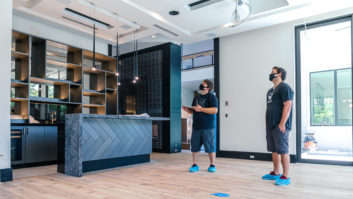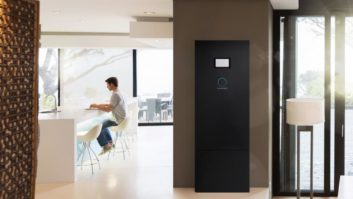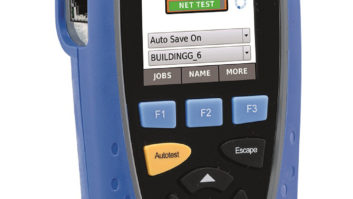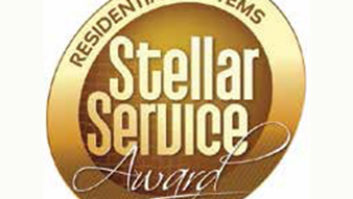Today the audio video business is all about networking. A short time ago the term networking at CEDIA meant catching up with other dealer and manufacture members from around the country and meeting the new comers every fall. But now days it means a whole lot more. It seems as if every sub-system being installed into new homes requires more and more networking skills. Those of you who just returned from the CEDIA EXPO were able to choose from two Home Networking Tracks.
The objective of the CEDIA Home Networking tracks was to give class participants a solid, fundamental understanding of distributed data systems throughout the home. Equal in importance to the understanding of distributed audio and video systems, whole-house data distribution represents an emerging business opportunity in infrastructure wiring, hardware components, and system configuration and control.
The classes in those tracks closely examined the product and technical knowledge required to have a successful and profitable home network integration business.
The management track was more for the operations side of the AV business, and was geared to the business owner that is trying to understand and evaluate the business opportunities that expertise in home networking represents.
The Technical track was geared toward the installer that wanted to get introductory and intermediate knowledge on what he or she needs to know to become successful in the implementation of home networking solutions.
This article is an extension of the CEDIA session “Effective Home Network Troubleshooting.”
“The rule is if you want power, grab the new technologies before anyone else does and run with it. Take it in your own peculiar directions, and then the rest of the world will have to catch up, both with the technology and with your directions.” –Stewart Brand, President of The Long Now Foundation.
The key to the success of any home network installation is quickly and effectively troubleshooting the home network. In this article we review the principles of how each component communicates with each other, from the Internet through the gateway and into the home network. When a communication link breaks down it is important to quickly diagnose where the break has occurred and what are the necessary remedial steps.
Let’s review how the data is transmitted across an Ethernet network. We will concentrate on devices that use the TCP/IP set of protocols. TCP contains four layers or protocols: Network, Internet, Transport and Application.
The network layer is used to receive and send packets. This is where the MAC or Media Access Control address is located. This is the hardware address and is formed by a 12 character hexadecimal address. The first six characters are unique to the manufacture and the last six form a unique serial number. An example of a CEDIA MAC address would be 00:10:7F:34:0B:A6 which would tell you that the device was manufactured by Crestron.
The Internet layer contains the protocols that are responsible for addressing and routing of packets. This layer contains several protocols including Internet Protocol (IP), Address Resolution Protocol (ARP), Internet Control Message Protocol (ICMP) and Internet Group Message Protocol (IGMP). This is where the IP address is located. In IPv4 this is expressed as a 32-bit address made up of four decimal numbers separated by periods. These four decimal numbers representing the 32 binary digits separated into four equal parts are called octets. An octet is 8 bits. This address is further divided into two parts, the first part indicates the network the device is configured to work on, and the second part indicates the unique address for that particular device.
IP addresses are divided into five classes. All addresses are placed into a particular class based on the decimal value of their first octets. In the first octet an address can start with a decimal value between 1 and 255. The Internet Network and Information Center (InterNIC) has reserved certain address for private use only. Setting up a client’s home for use with an AV network you would typically use addresses in the class C range of 192.168.0.0 through 192.168.255.255. Routers on the Internet will not route data from or to these addresses.
“If you think training is expensive, try going without it.” – The late Dave Thomas, Founder of Wendy’s.
In IPv4 your maximum total number of unique IP addresses with 32 bits is 4,294,967,296. This brings me to a CEDIA Urban Legend: “If everything we are installing has its own IP address won’t we run out soon?” The answer is no. IPv6 is being implemented now on the backbone infrastructure of the Internet, and if you have already installed service pack 1 for XP on your laptop, then you’re ready for IPv6 now.
IPv6 has a 128-bit address expressed in a hexadecimal form. The maximum total number of IP addresses is a staggering 340,282,366,920,938,463,463,374,607,431,768,211,456. This is over 340 Duodecillion or 2128 addresses. This is an extremely large number of unique IP addresses. Let’s put this number into another context. The earth’s surface is roughly 511,263,971,197,990 square meters. With IPv6 you would be able to install 665,570,793,348,866,943,898,599 network devices all with unique IP addresses onto every square meter on the planet. Even the largest homes you are working on would NEVER run out of addresses.
Let’s say we have just installed an Audio Request ARQTERA-960 and you want to give it an address of 192.168.2.100, you would express this as 0:0:0:0:0:0:C0A8:0264 in IPv6.
Subnet Masks are 32-bit address that accompany IP addresses and indicate which portion of the value is referring to the network device. The IP address and Subnet address are interrelated and only have meaning in the context of the other.
The Transport Layer determines whether the sender and the receiver will set up a connection before communications and how often they will send acknowledgments. This layer will segment the data received down from the application layer into appropriate bite sized chunks (specified by the network layer) and then pass the data down to be sent to the destination network device.
The Transport Layer uses two protocols: Transmission Control Protocol (TCP) and the User Datagram Protocol (UDP). Whereas TCP sets up a connection and sends acknowledgements, UDP does not. UDP can move data very quickly, but TCP guarantees delivery. The Application Layer is where requests for data or services are processed. Applications at this layer are waiting for requests to process and they are listening at their respective ports.
TCP and UDP have use of 65,536 ports each. An example of this would be a Network Keypad user interface with a graphical display would be monitoring port 80 for data sent to it by a Network Speaker. This is the standard port to listen for HTTP requests.
The flow of information through the TCP/IP stack is called a socket. A socket contains three pieces of information: The IP Address, the TCP or UDP and the port number. A socket could be written like this 192.168.5.6:TCP:80. Port numbers between 1 and 1,024 are considered well known and are ports that the Internet Assigned Numbers Authority (IANA) have reserved for specific applications for example port 80 for HTTP. Some well know CEDIA ports are:
TCP:1319 AMX-ICSP
TCP:1320 AMX-AXBNET
TCP:3074 Microsoft XBOX
TCP:3663 Audio Request
TCP:9999 Premise Systems
TCP:41794 CRESTRON
TCP:41795 CRESTRON
“We spend 90 percent of our time rolling around in the bottom two TCP/IP layers!” – Networking Legend Dan Novell
By learning and understanding more about the way data travels around the TCP/IP network, you will be able to analyze, compare and troubleshoot network problems.
The CEDIA Ten Home Networking Laws:
1) It has to work
2) Some things in life can never be fully appreciated nor understood unless experienced firsthand. Some things in home networking can never be fully understood by someone who has never been in a basement or attic crawlspaces pulling wire with a Mag-lite in your mouth as the only source of illumination.
3) No matter how hard you push and no matter what the priority, you can’t increase the speed of light.
4) With sufficient thrust, pigs fly just fine, however this is not necessarily a good idea.
5) It is always possible to agglutinate multiple separate problems into a single complex interdependent solution. In most case this is a bad idea.
6) It is easier to move a problem around than it is to solve it
7) It is always something, Good, Fast, Cheap, pick any two because you can not have all three.
8) It is more complicated that you think
9) For all resources, whatever it is, you need more. Every home networking problem always takes longer to solve than it seems like it should.
10) Every old idea will be proposed again with a different name and a different presentation, regardless of whether it worked.
Network problems can be split into two flavors: network communication configuration errors or software, and network installation problems or hardware.
Packet InterNet Groper (PING) is a very basic yet highly useful diagnostic tools that you can use to help find problems. Armed with Ping you can check the connectivity of your network very quickly. Ping sends a packet from one device, attempts to “bounce” it off another, and “listens” for the reply. If you get a prompt reply then the bit of network between the pinging device and the “ping” device is okay. The best strategy when troubleshooting is to start pinging devices that are near to you and then to try to ping devices that are progressively more remote. If you fail to ping a device then you’ve isolated the problem.
The way in which ping may fail can sometimes give a clue as to what’s wrong. The kinds of failure messages you’ll see are, “No answer from [destination]” or “No reply from [destination].” This is the most usual failure you’ll see and indicates that your local system at least thinks it knows how to get to the destination.
Another one is “ICMP host unreachable from gateway.” This is an interesting message and indicates that while your system knows that it needs to get at the destination via a gateway, that the gateway itself doesn’t know how to route packets on. It may be because you have set the local gateway address incorrectly and does not necessarily indicate a network problem.
One that reads, “[Destination] is unreachable” usually indicates that your local system does not know how to get to the destination, often caused by not having any routing information available. (Note, however, that PC-NFS will report this failure when it can’t get a response from a device on the same subnet.)
So, by acting rationally and systematically, we now can use ping to isolate a network fault. Help can be had at www.pingplotter.com Okay, now the for the Top 10 Networking Problems:
1) IP addresses entered incorrectly. All network devices on the same physical segment must have the same network ID and a unique ID.
2) Subnet mask incorrect. The subnet mask specifies the network portion of the address. Make sure you have the right subnet mask for your network class.
3) Default gateway entered incorrectly. If you can communicate with other local network devices, but you cannot communicate outside your network then check this address first.
4) Incorrect gateway setup.
5) Invalid WAN/LAN addresses.
6) RJ45 connections are not terminated properly.
7) Wall plates are not installed properly.
8) Installation is poor or not performed correctly.
9) Wire is damaged during pre-wire. Opens, shorts, improper bending radius, pulling with electrical wire, staple pinching or breaks. Other wire problems. Crossed, reversed, or split pairs.
10) No documentation, wrong wires, no labels.
More information on network wiring issues can be found at www.flukenetworks.com
Michael Braithwaite ([email protected]) is CTO of NetSTreams in Austin, Texas.







